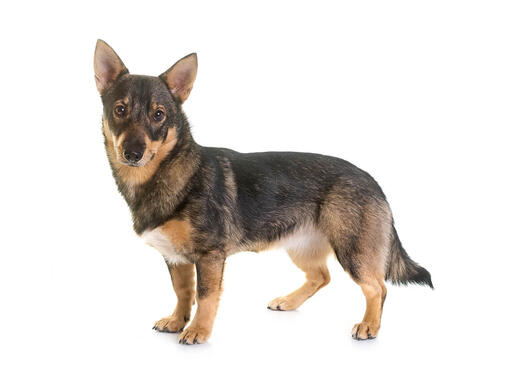
The Swedish Vallhund is a hardy herding dog with a long, muscular body and short, stocky legs. He can have a full curled tail, stub tail or no tail. Alert and confident, the Swedish Vallhund is an excellent watchdog and protector without being overly aggressive. He is steadfast, spirited and sweet, making the breed a good family companion. This active, athletic dog requires ample daily exercise.
DID YOU KNOW? An ancient breed developed to herd cattle and sheep, the Swedish Vallhund originated more than 1,000 years ago during the Vikings era in Sweden. This dog was previously known as the “Vikingarnas Hund,” or the “Viking Dog.” The Swedish Vallhund has been featured on postage stamps in Sweden, Nicaragua, Ukraine, Mali, Russia, and Tajikistan.
The need-to-know
- Dog suitable for owners with some experience
- Some training required
- Enjoys active walks
- Enjoys walking one to two hours a day
- Medium dog
- Some drool
- Requires grooming every other day
- Non hypoallergenic breed
- Very vocal dog
- Guard dog. Barks and alerts
- May require training to live with other pets
- May require training to live with kids
Personality

Clever, lively and alert, the Vallhund is a natural watchdog, informing their owners of anything interesting, suspicious or unusual that they have seen or heard! Friendly and amenable, they are a loyal companion and enjoy spending time with their people. Easy to train with the right motivation, the Vallhund will enjoy a variety of doggy activities, but beware leaving a Vallhund to get lonely or bored – they will bark and become destructive if so!
History and Origins

Also known as the Swedish Herder Spitz or the Swedish Cattle Dog, the Vallhund is thought to be almost 1000 years old. Believed to be related to the Pembroke Welsh Corgi (although opinions differ as to which came first), it is clear at a glance that the two breeds share some similarities in function and form. The Vallhund’s original function was to herd and drive cattle but as a useful farm dog they would also perform the role of watchdog and ratter. Despite this usefulness, the breed nearly died out in the 1930’s but thanks to the efforts of Count Bjorn von Rosen and a group of dedicated supporters and breeders, numbers rose again and the Vallhund found favour as both a show dog and a family pet. Recognised by the Swedish Kennel Club in 1940, it wasn’t until the 1980’s that they achieved recognition by the UK Kennel Club.
Nutrition and Feeding

The Swedish Vallhund needs to have a balanced diet including all the main nutrient groups and a constant supply of fresh water. It's also important to conduct regular?body condition?scores to ensure you keep your dog in ideal shape and remember to feed him at least twice daily and in accordance with the feeding guidelines of their particular food.
Exercise

The Swedish Vallhund needs at least an hour of dog exercise as despite their small size this is a sturdy working dog. They will also require some form of mental stimulation on top of physical exercise to replace their daily engaging farm work. Intelligent and versatile, the Vallhund is capable of many canine sports and activities, from herding cattle or herding games such as Treiball/Sheepball, to agility, Hoopers, man-trailing and more. Some have even turned their paw to obedience.
Other Information

Health and common issues
The Swedish Vallhund is generally a healthy breed. As with many breeds, eye disorders and hip dysplasia (a condition that can lead to mobility problems) can arise and so eye testing and hip scoring of dogs prior to breeding is recommended.
Space requirements
The Vallhund is not a large dog and will not require a huge home, however a good-sized secure garden is a must. Given their tendency to bark, and desire to herd moving objects, they are probably better in a quieter location whether rural or suburban. Access to interesting and varied walking routes and secure locations for off lead play are essential.
Training swedish vallhunds
As a working dog, the Vallhund retains the ability to think and act independently which means owners should work hard to build a bond and motivate their dog to want to work with them. Consistency and positive reinforcement-based methods will be effective and will make dog training sessions with the Vallhund fun. Pay attention to training a solid recall as despite their short legs the Vallhund can be far away very quickly and has the stamina to keep going! Early dog socialisation with animals and people is essential, and you’ll need to be prepared to teach them only to herd on request, and to be quiet on cue!
Best family dog breeds
The Swedish Vallhund makes an excellent family pet for those who enjoy walking and taking part in training or other dog related activities. Beware their desire to herd moving objects, and as cattle dogs, they are nimble, bold and not averse to nipping to make someone move and so are not good in families with small active children. Homes with older children, teenagers and those without children will find the Vallhund an engaging and intelligent companion who is affectionate and fun to live with. While many dogs are traditionally thought of as being good with children, all dogs and children need to be taught to get on with each other and be safe together. Even so, dogs and young children should never be left alone together and adults should supervise all interactions between them.
Did you know?
Vallhunds are so versatile, they have taken part in herding, agility, flyball, obedience, vermin control, search and rescue and have even been trained to sniff out valuable truffles. For a relatively unknown breed, the Swedish Vallhund has featured on a remarkable number of postage stamps including those from Tajikistan, Mali, Nicaragua, Ukraine, Russia and of course, Sweden.